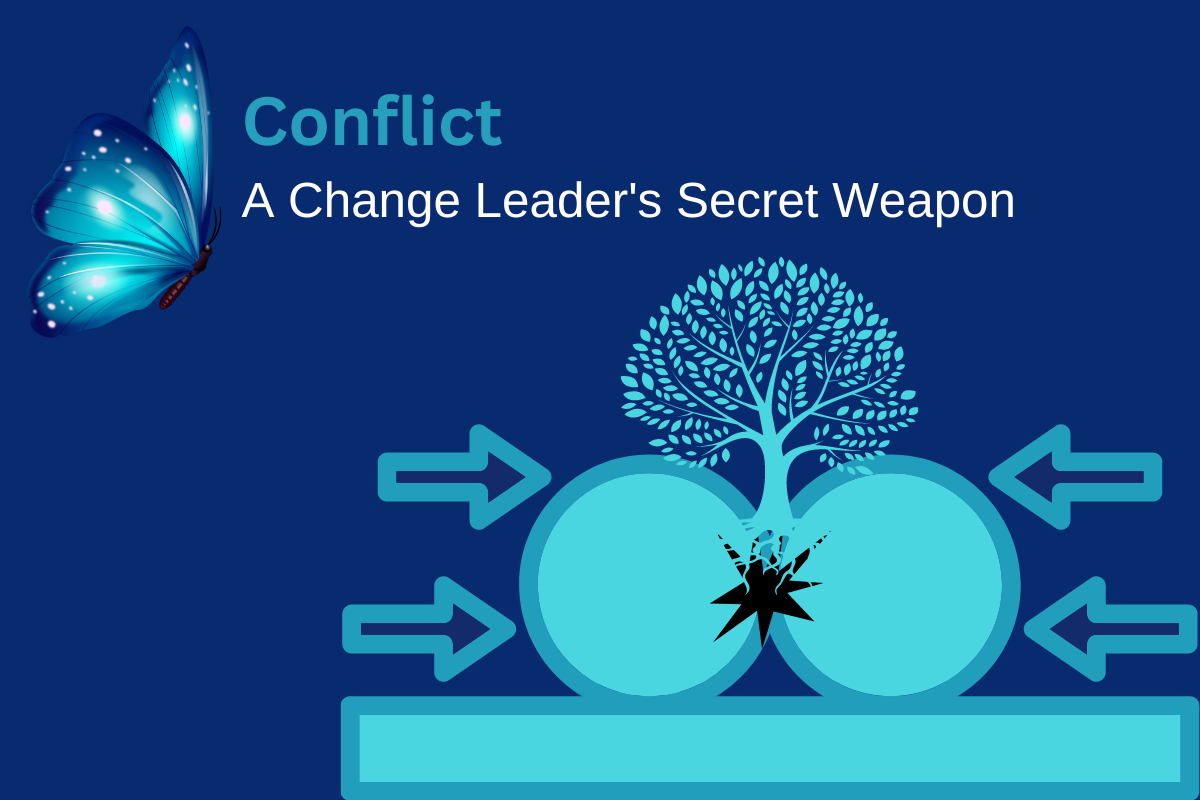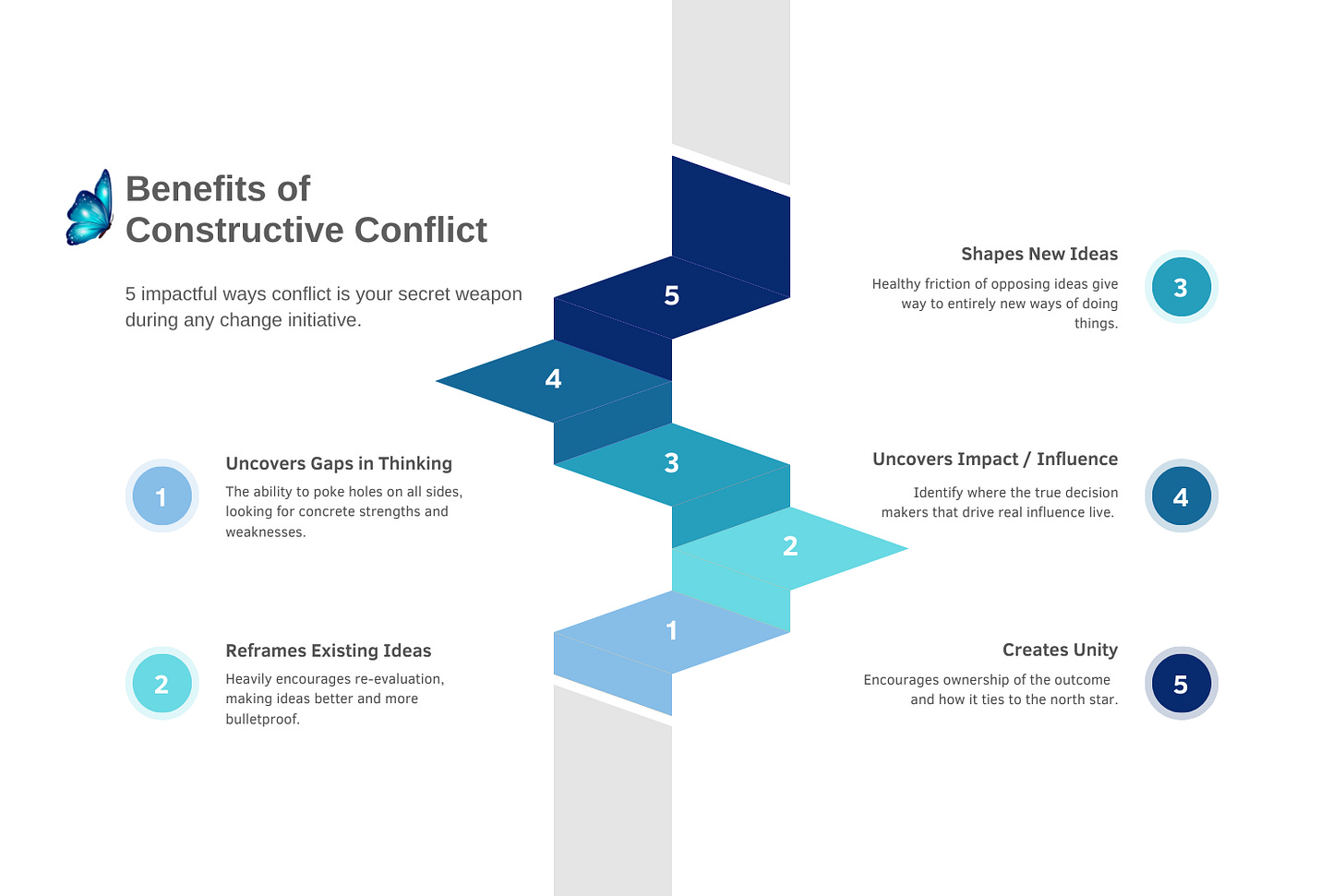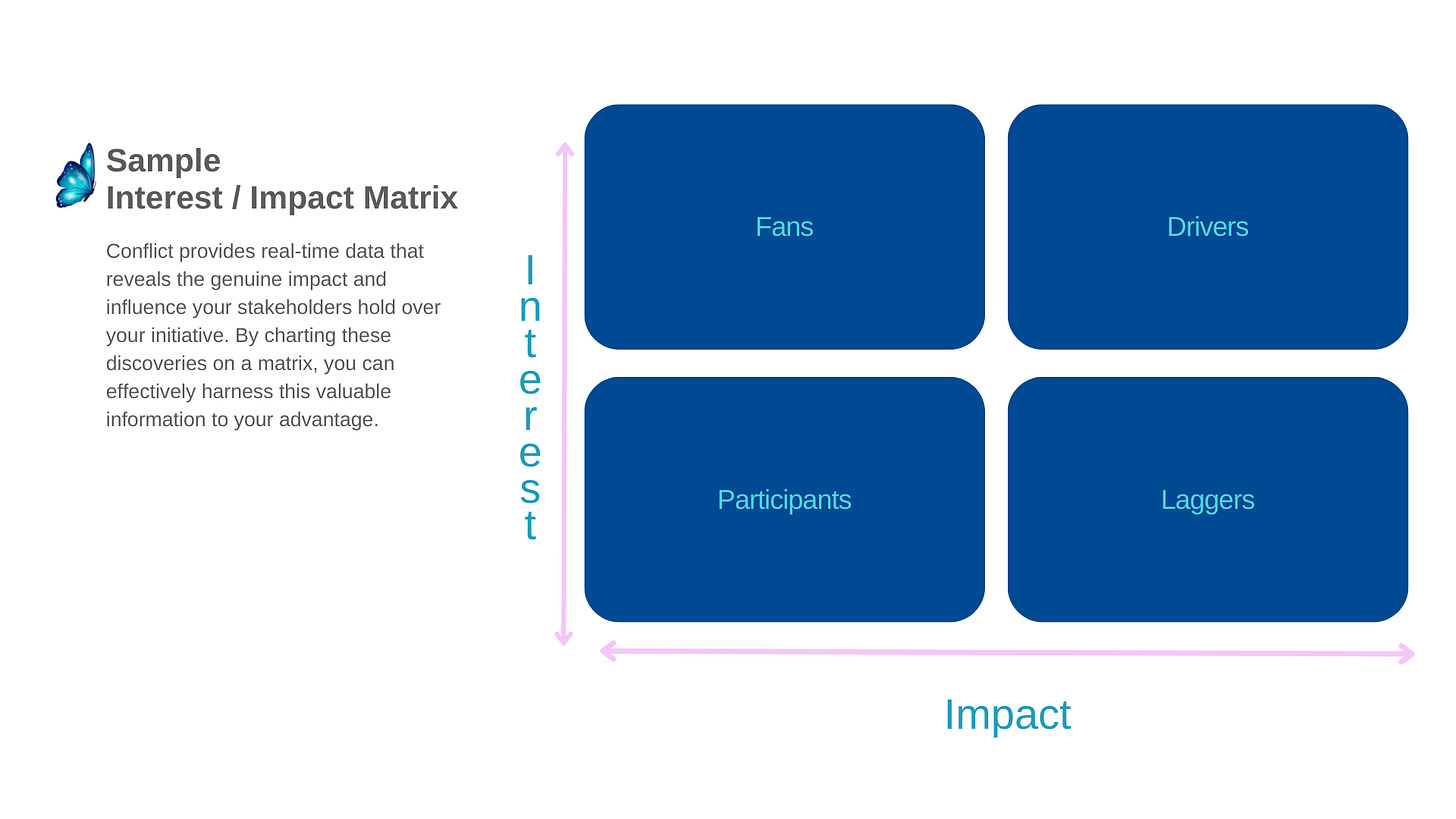Conflict: A Change Leader's Secret Weapon
(#006)
In 2017, I was entrusted with leading one of the most ambitious projects in our company's history: the migration of all our clients' solutions to the next iteration of our platform. This was a high-stakes initiative with stakeholders across the globe and at all levels of the organization.
As the program lead, I found myself navigating a minefield of conflicting priorities, competing interests, and intense emotions. Our leadership team was under pressure to deliver results quickly, which often led to heated discussions about resourcing, execution, and communication. Meanwhile, our clients had their own set of demands and expectations, which sometimes put them at odds with our internal teams.
Despite the initial discomfort that arose from all this conflict, it left me with a deep sense of confidence that we were on the right track.
The reason? I view conflict a bit differently after having experienced it for many years. After witnessing the outcome of the large scale migration project for my company (it was a massive success) and many others just like it, conflict has become not only a welcome companion to change, but a much needed secret weapon that speeds up the process of tying strategic ideas into concrete reality.
The Perception of Conflict
Are you afraid of conflict? You're not alone. In the high-pressure environment of the modern workplace, it's not uncommon for change leaders to envision conflict as nothing but bad news. Whether it's a disagreement with a colleague, a clash of personalities, or a full-blown power struggle, conflict can be an intimidating and overwhelming prospect for even the most experienced professionals.
To make matters even more stressful for those that view conflict incorrectly, the larger the team at their helm, the more conflict comes up in new ways and the level of ambiguity keeps climbing.
The truth is, conflict can actually be an opportunity for hyper growth and innovation. When we view conflict as a threat, we miss out on the valuable insights and perspectives that can come from engaging in healthy dialogue.
Let’s put this into perspective with a quick example that’s all too familiar for project leaders and change agents:
You're in a team meeting and someone proposes an idea that you know won't work. You're afraid to speak up and contradict them, so you stay silent. The team agrees to the idea, and it's implemented. But it's a disaster. Everyone is blaming each other, and the project is falling apart. If only you had spoken up, the team could have avoided this mess.
In reality, conflict is almost inevitable when initiating transformation projects. It can stem from differences in opinion, competing priorities, or resistance to change. Instead of running away from conflict, however, you should view it as an opportunity to propel your company forward towards its objectives.
To be clear, managing conflict is no easy task. It can be frustrating, tense, and time-consuming. But the payoff is worth it. When conflict arises among my team, I know we are on the right track towards success.
In this article, we'll explore the various aspects of conflict when dealing with transformative projects. We'll begin by defining conflict and then answering some fundamental questions.
First, we'll explore why conflict is considered a good thing when initiating change.
Second, we'll discuss how you can navigate constructive conflict to ensure the right business outcomes are met and accelerated.
Next, we'll dive into how you can encourage positive conflict and why it's essential.
Lastly, we'll provide tips on how to manage conflict from getting out of hand.
By the end of this article, you'll become a true advocate for conflict and become masterful at shaping it in a way that brings even the most aspirational strategic goals to life.
So, in order to embrace conflict as our secret sauce, let’s first put a proper definition to it.
Defining Conflict
Conflict is a topic that often brings to mind images of large scale arguments and full blown confrontation across team members and stakeholders. Defining conflict in this way is the wrong approach. What I just described is surface level. Symptoms that bubble from not managing conflict appropriately. It also frames conflict in a negative light in all cases. Something inexperienced change leaders all too often fall for.
With the understanding that arguments and confrontations are merely symptoms of conflict, it’s time to paint a picture of what conflict truly is. I’ve purposely kept this definition broad to account for wide applicabilities to all project types and industries.
At its core, conflict arises when two or more parties hold differing opinions about a particular cause, process, or approach.
Conflict can take many forms and is often a natural part of any relationship or team dynamic. In a workplace setting, conflict may arise over disagreements about project timelines, differences in work styles, or conflicting ideas about how to approach a problem.
Reading the above definition should help you begin to see what a massive and untapped opportunity lies in your way leading large scale initiatives.
Why Conflict Is Your Secret Weapon
If you’re still not sold that conflict is the accelerator you need to take any initiative, regardless of its size, on a rocket ship to success, I have a strong belief that this section will change your mind.
Let’s start with change itself. In order to create change and have any hope for wide-scale adoption, you must focus and overcome 3 key obstacles:
Alignment - Obtaining and distributing a crystal clear vision on what the end result of your change, once complete, looks like.
Winning Buy-in - The ability to turn skeptics across and outside your organization into avid believers.
Integration - Penetrating the new product, service or process into every area it’s expected to provide transformation and value.
Looking at each of these on their own silo, it’s easy to see the amount of work you have in front of you. Collectively, you’re left with an absolute beast that’s hard to manage at the best of circumstances.
Now, without conflict, the pace you’ll move in completing each of these obstacles will be at a snails pace. And that’s a pretty good outcome. Purposely avoiding conflict may even give you the impression you’ve checked off all the boxes. Instead, your’e left with change that completely misses its mark in terms of executing on strategy. In other words, you have a failed initiative on your hands.
With constructive conflict present and managed by a seasoned change leader, getting alignment, buy-in and integrating change can actually happen and in proper fashion.
Conflict is also your secret weapon in other unique ways when leading organizational change. Here are 5 of the most impactful you may not have thought about before:
Uncovers Gaps in Thinking
Change is a colossal task, and it comes with a mountain of communication hurdles. From differences in skill sets to varying cultures and values, the road ahead is treacherous. To make matters worse, as humans, we tend to perceive change through the lens of our unique traits and experiences. It's like trying to navigate a maze blindfolded!
Thankfully, there is a solution to this perplexing problem: constructive conflict. By allowing each party to state their case, we open up a world of possibilities. Constructive conflict pokes holes in every argument and brings to light different perspectives, ultimately leading to better outcomes.
As a change leader, it's crucial to remain laser-focused on the conversation and facilitate it in an unbiased manner. This way, we can quickly identify the pros and cons of each approach and build better plans that push the organization forward.
Reframes Existing Ideas
Ideas are the lifeblood of progress and innovation. But let's face it - they're often fragile, vulnerable, and in need of some tough love to reach their full potential. That's where conflict comes in. By embracing conflict and approaching it with a growth mindset, we can transform ideas from mere possibilities to fully-formed solutions.
But conflict is not about attacking people. It's about attacking ideas - dissecting them, analyzing them, and testing them against every conceivable scenario. When we engage in this process, we're able to see the strengths and weaknesses of each perspective, and we can reframe them for the better.
This is where the magic happens. By leading through conflict, we're able to create an environment where team members feel empowered to question and examine their own ideas, not just others. It's not about winning or losing - it's about uncovering the best possible solution. And when we encourage this healthy process, we set ourselves up for truly great ideas that have the potential to drive true change.
Shapes New Ideas
With a much more comprehensive view point for each side, something magical begins to happen. When played right, constructive conflict can secretly be transitioned into a brainstorming session. Think about it, if you eliminate the competitiveness of the situation, conflict is merely the expression of different ideas, viewpoints and approaches.
As a change leader, it’s your job to take these diverse ideas and shape them into something new and innovative. The ultimate goal is to propel your organization forward through positive change, and the best way to achieve that is by embracing conflict as a catalyst for progress.
Uncovers The True Impact & Influence
One of the key roles of a change leader is to assess the landscape and identify the key individuals who can significantly affect their initiative, whether positively or negatively. Uncovering these stakeholders comprehensively is indeed a challenging task, but it is achievable.
However, translating your observations onto paper may not capture the reality of the situation. It is through moments of conflict that you truly witness people's genuine reactions. When conflicts arise, you have the opportunity to observe how individuals respond to crises, disagreements, and confrontations.
Your job is to focus on the behaviours of these individuals and their audience, searching for clues about their true influence and impact. You will witness firsthand who steps up, who possesses significant decision-making power, and who among them are merely pretenders. By combining your initial findings with the observation of conflicts, you gain a better understanding of each stakeholder's position. Personally, I find it helpful to use an impact/influence matrix, which provides a visually clear representation.
This information holds immense value. Constructive conflicts provide a glimpse into whom you should monitor closely, who to turn to in times of need, and which stakeholders can swiftly remove obstacles when pivotal decisions must be made.
Create Unity Through “One True Goal”
Conflict holds one final hidden gem, capable of elevating any change initiative to greatness. When handled constructively, it offers a transformative opportunity for teams to gain a deeper understanding of the best path forward. It may bruise a few egos along the way, but through true collaboration, everyone's input is heard and carefully considered.
Don’t take this moment for granted. Embrace this golden opportunity that conflict presents before you, for within its grasp lies the potential to forge unwavering unity on a grand scale. As ideas resonate and undergo meticulous refinement, stakeholders experience a profound sense of ownership, even if they fiercely challenged the initial concept. It becomes their very own creation, a testament to their commitment.
From this process, a singular source of truth emerges, illuminating the path for the rest of your project. With a collective mission that resonates with every team member, unity is established, and friction is eliminated. This paves the way for an outcome that is not only precise and valuable but also a powerful testament to the collaborative strength that binds your team together.
With a clearer picture of conflict in a positive light, I hope you don’t get the impression that this is easy to implement on every occasion. Conflict can very easily transition into the bad kind. The final section will show you what to do in these scenarios.
Managing Conflict
In the workplace, conflict often arises, particularly during times of change. Unmanaged, it can lead to heightened emotions, insults, and deep-seated resentment. As a result, productive sessions turn toxic, overshadowing the pursuit of company objectives. This undesirable outcome is the last thing a change leader wants on their hands.
You’ll want to arm yourself with a few managerial tactics to stop bad conflict from happening and only allowing constructive conflict to see the light of day.
Step 1 - Anticipate: Great leaders understand the personalities of their stakeholders on a broad scale. They uncover what their values are and what drives them. While this is a great mechanism to provide encouragement, it’s also perfect for anticipating and planning for potential conflict. Conflict tends to first reside internally and bubble up as the scenario plays out. Being able to anticipate conflict before it surfaces allows to to fly through the remaining steps with ease.
Step 2 - Identify: When conflicts transition from potential to actual, it is crucial for the change leader to possess sufficient awareness to recognize this transformation. During confrontations or disagreements, closely observe body language and tone of voice. Are the individuals involved crossing their arms? Are they speaking in a raised and agitated manner? Is the conversation shifting from business matters to personal? These unmistakable signs should serve as triggers for you to intervene.
Step 3 - Oversee: So, a conflict is unfolding, and you find yourself right in the midst of it. By this point, you should have a solid understanding of the situation and may even have a preference for one side. However, it's crucial not to fall into this trap. Instead, your role should be that of a mediator, remaining objective and unbiased as the conflict progresses. Your focus should be on creating situations that foster unity ('we') rather than self-interest ('me'). The ultimate goal is to find a solution and keep the momentum going, with the business outcomes at the forefront.
Step 4 - Own: This is arguably the most crucial step for the change leader to manage. Conflict is at its peak, with all sides having presented their cases by this point. As diverse viewpoints surface, the change leader should encourage these novel ideas as team-owned outcomes. Since humans are resistant to imposed change, fostering a mindset that perceives the conflict's resolution as a product of the team's collaboration will greatly enhance the likelihood of gaining long-term buy-in from them.
Step 5 - Align: Things are beginning to take shape, and a positive outlook is within reach. It's crucial not to lose the momentum you gained. As someone who truly understands the company strategy and comprehends the significance of this project in driving the company forward, you have a distinct advantage. Can you find a way to align the resolution of the conflict with the company's goals? If you can establish a connection between the desired (and owned) outcome outlined in step 4 and its potential impact on the organization, you will be making one of the most powerful moves as a change leader.
Step 6 - Follow Up: By this point, you should reflect on how something that could have derailed your plans ended up being a significant boost to your change initiative. However, don't let yourself get too comfortable just yet. It's common for issues to resurface. Take a proactive approach by scheduling regular alignment meetings, either as a group or on a one-on-one basis. Emphasize the successes that have resulted from resolving conflicts and highlight their impact. At the same time, subtly watch out for any signs that conflict may be brewing beneath the surface and be prepared to revisit steps 1-5 if necessary. Through consistent communication, you'll be better equipped to navigate any potential challenges that lie ahead.
It’s Time to Embrace Conflict
Conflict will never be fully avoided, nor should it be. With the right mindset and leader in place, there is much to gain from a healthy dose of constructive disagreements on the path to fresh ideas and complete alignment.
The next time you're managing the next big thing set to disrupt your organization, embrace conflict as the catalyst for real change and growth.





